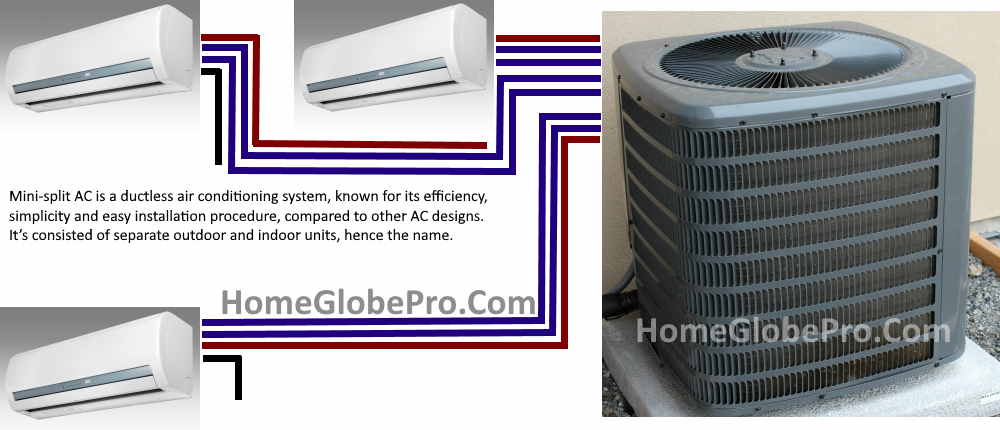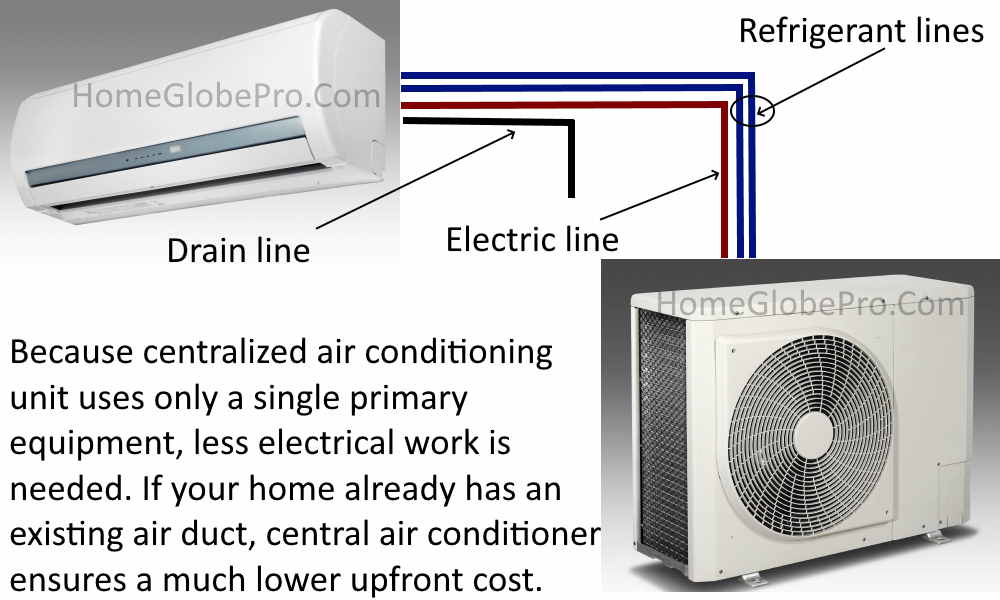Mini-split AC is a ductless air conditioning system, known for its efficiency, simplicity, and easy installation procedure, compared to other AC designs.
It’s consisted of separate outdoor and indoor units, hence the name. If you choose mini-split AC, it’s easy to install indoor units throughout your home. Because they are relatively light and small in size, you can easily install the wall-mount indoor units anywhere inside your home. These indoor units contain a blower and evaporator coil, while the outdoor units contain a pressurized refrigerant and compressor.

Refrigerant is sent to the evaporator coils inside the indoor unit to cool warm air. Heat is absorbed by the refrigerant, which is sent back to the outdoor unit. If you are considering mini-split AC units for your home, here are things to consider:
How does split type aircon work?
Split type air conditioners are composed of two separate units: an outdoor unit and an indoor unit. The outdoor unit houses the compressor, condenser coil, and expansion valve. The indoor unit includes an evaporator coil, a blower, and an air filter.
When the air conditioner is turned on, the compressor compresses the refrigerant and sends it to the condenser coil where it releases heat to the outside air. The cooled refrigerant then travels to the expansion valve where its pressure is lowered, allowing it to absorb heat from the indoor air. The refrigerant then travels to the evaporator coil, which further cools the air. The blower then pushes the cooled air through the air filter and into the room.
Mini-Split AC Pros
- Easier control – Indoor units of mini-split ACs are very easy to control with a thermostat, mobile app, or remote control. A centralized air conditioning system is inefficient if you want to cool only a few rooms in the house. Each member of the family may have different preferences on indoor temperature, so mini-split ACs are better for them. Rooms in your home are usually not used all the time. The home office area and bedrooms are used only at certain times of the day, while guest rooms are used occasionally. If you recently expanded your home, new rooms may not have ducts, so it is more convenient to set up mini-split ACs.
- More efficient – Centralized air conditioning systems and ducts can be up to 30 percent less efficient, due to loss of cold air. If you install mini-split ACs, energy loss can be drastically reduced and this will be reflected by lower electricity bills. Depending on the size of your room, you can choose smaller AC units that are more affordable and have lower energy requirements.
- Better air quality – Poorly maintained ducted HVAC systems can affect your indoor air quality. Often, you need professional service to clean out the central air conditioning system and its ducts. Many mini-split AC units have removable and washable filters. You can easily wash the filter with running water and air dry it, before putting it back into the indoor unit.
- Less humid – Compared to other air conditioning types, mini-split ACs work well in dehumidifying your interior. Because you have multiple indoor units throughout the house, they can easily remove excess humidity. If you are living in a humid region, choose mini-split ACs with “reheat dehumidification mode”. When enabled, this feature removes humidity from your interior while keeping a constant temperature.
- Better placement – The placement of indoor AC units depends on the layout of your interior. Proper positioning maximizes the impacts of your indoor units to reduce energy consumption. It is easier to move indoor units to a better location, especially after you reposition beds and couches.
Mini-Split AC Cons
- Higher upfront costs – Although installing ducts can be expensive, you only need a single high-performance central AC unit. On the other hand, you need to buy plenty of mini-split ACs, if you have many rooms in your house. It may cost up to $12,000 to get full coverage with mini-split ACs in a mid-sized home.
- More energy requirements – Multiple mini-split ACs require more energy compared to a single centralized unit. If you keep them running, the total energy consumption can be very high. Mini-split ACs can be efficient only if you turn on indoor units alternately, not all at once. If energy consumption is very high during a hot summer day, you may need to upgrade the electrical panel.
- Poor aesthetics – Most wall units have white or bright colors, which don’t match your interior design. It can be difficult to find the right color for the indoor unit that is suitable for your indoor design.
Comparison with central air conditioner
There are plenty of arguments for why mini-split ACs are preferable to centralized ones. As mentioned above, you can have more refined control of the indoor temperature. Because ducting isn’t necessary, mini-split ACs are more efficient, because cool air doesn’t escape through ducts. When used to heat up your room, mini-split ACs can be four times for efficiently. If you choose mini-split ACs with a built-in dehumidifier feature, they work well for removing excess humidity.
But, in terms of aesthetics, the central air conditioner is less obstructive, because there’s no visible wall-mounted unit. Because a centralized air conditioning unit uses only a single primary piece of equipment, less electrical work is needed. If your home already has an existing air duct, a central air conditioner ensures a much lower upfront cost.
Comparison with window air conditioner
If there are a few rooms in your apartment and summer days are generally mild in your area, it can be compelling to choose window AC units. Compared to mini-split ACs, window AC units are usually more affordable, because they are sold as a single unit, instead of two separate units. If you have a large window with a suitable design, installing a window AC unit is generally easy. However, because the windows air conditioner is a single-unit model, it tends to be noisier.
The outdoor part is just outside the windows and the noise can be louder if the AC unit is in the dehumidifying cycle. Installation of window ACs may compromise the security of your house because it’s relatively easy to remove some window AC models from the outside. If you prefer to maintain the aesthetics of your interior, window ACs appear more intrusive than wall-mounted units of mini-split AC. If you choose mini-split ACs, they will only hear the smooth whisper of the indoor unit and you will be kept safe from potential burglary.
FAQs
For typical home and small business uses, ductless mini-split ACs are now the reigning champion over other AC designs due to their inherent advantages. Even so, there are a few things you need to know about this type of AC.
Some areas in your home can be relatively cool or warm without an AC system. A room may already feel comfortable without extra dehumidification, cooling, or heating equipment. Use your common sense and you may find it unnecessary to install an AC system in some rooms. With proper placement, a single indoor unit may help to cool several rooms or a large part of your home.
Because mini-split ACs have separate outdoor units, they are generally much quieter than wall-through or window-mounted AC units. Depending on the model, the noise level of the indoor unit is somewhere between 20dB and 50dB. Generally, you will only hear the smooth whirring noise of the indoor unit. If you are very sensitive to noise, it is preferable to choose a centralized air conditioning system that blows cool air into your bedroom through ducts.
If you know how to do electrical work and mount mini-split units securely on the wall, it is possible to install it yourself. It is a good idea to read the user’s manual and watch instructional videos before doing this DIY project. However, hiring a professional HVAC technician is more beneficial than doing it yourself. A licensed professional can do their work quicker and safer. You will avoid unnecessary mistakes that cause damage to your home or the AC unit itself. Some manufacturers only offer warranties if their mini-split AC units are installed by licensed HVAC technicians.
Filters should be washed every 500 hours of use and they have a lifespan of up to eight years. It is generally easy to remove the filter and you can wash it under running water with mild detergent. Some mini-split AC models have a warning light to notify you when it’s time to wash the filter. You may need to call an HVAC technician to clean up the inside of the outdoor unit and check its refrigerant level.
When maintaining mini-split ACs, you need to check them separately. One common issue with mini-split AC is the gradual degradation of the line-set insulation. Rodents may sense the presence of moisture and bite into the insulation of the line-set to get to the water. It’s more likely to happen if you place line sets horizontally, instead of vertically against the wall. Brittle or chewed-up insulation should be replaced immediately to maintain the performance of your AC unit and prevent corrosion.
With regular maintenance and parts replacements, many mini-split ACs can last for more than 15 years. Smaller mini-split units are generally less prone to issues compared to larger central-cooling models. Be sure to get your products from reputable brands with a good warranty and after-sales services.
If you have carefully designed your interior, it can be tricky to incorporate your indoor AC unit. Instead of just mounting the indoor unit on the wall, you may experiment with certain creative placements, such as putting it in the bookcases or under the stairwell. As long as you don’t block the airflow, you can try anything to incorporate the indoor unit into your interior. Most indoor units are sold in white or black color, but some manufacturers offer some unique colors that match your wall.
Conclusion
A split air conditioner is a type of air conditioning system that uses two or more components to cool a space. The components are connected through refrigerant lines, which transfer heat and cold between the two. The main components of a split air conditioner are the outdoor condenser unit and the indoor evaporator unit. The outdoor condenser unit is responsible for compressing and cooling the refrigerant before it is sent to the indoor evaporator unit. The indoor evaporator unit is responsible for evaporating the refrigerant so that it can absorb heat from the air in the room. The cooled air is then circulated throughout the room by a fan. The refrigerant is then sent back to the outdoor condenser unit to be cooled again and the cycle continues.
